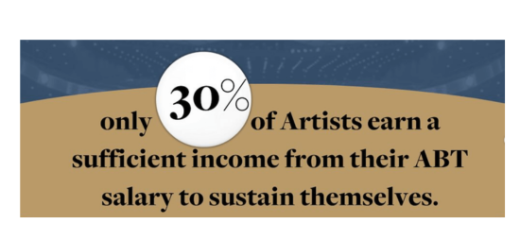
The ABT Strike and the Fight for Fair Wages for Dancers
by Rachel DeForrest Repinz
On the morning of February 7th, the American Guild of Musical Artists (AGMA) in collaboration with dancers and stage managers of American Ballet Theatre (ABT) announced a vote in favor of authorizing a strike if necessary for the nearly 85-year-old company via an Instagram post. The shocking declaration, which followed an eight-month period of failed negotiations for a fair contract, is the first time AGMA voted to authorize a strike since 2018.
The announcement prompted a slew of social media comments in support of a strike, and highlighted ongoing conversations about fair wages and working conditions for dancers and performing arts professionals. The ABT strike vote comes after the recent SAG-AFTRA and Writers Guild of America strikes in 2023. In the midst of these strikes and negotiations, Dance/NYC released their long-anticipated State of NYC Dance report, noting that the NYC dance industry is “contending with systemic inequity, changing audience participation, and ever evolving revenue models… Passionate dance workers persist in a project-based, freelance world, caught between opposing societal forces, navigating pandemic challenges, and enduring financial insecurity.” Despite dance workers' passion and persistence, the report’s findings state, “Dance is not financially sustainable for most of its workers.”
In a candid Instagram post following the initial strike vote announcement, ABT’s dancers shared testimonials about their company salaries that echo Dance/NYC’s findings: their jobs as dancers simply do not adequately cover living expenses, and company dancers are asked to endure long hours and dangerous working conditions, often without the resources to support this strenuous work. This is particularly dangerous given that being a professional dancer was named as the most physically demanding job in the country just 4 years ago. In a recent article by Teen Vogue, Alexandra Basmagy, an ABT corps de ballet dancer, shared their frustration with the disparity between the lived reality of being a dancer and how they are valued within the company: “They have said to us, 'We understand you're an integral part of the company.’ It's like, ‘No, no, we are the company.’”
As Dance/NYC reports, “Despite challenging conditions, dance workers find their work fulfilling and choose to persevere.” However, as Alexandra Basmagy noted in their Teen Vogue article, “The love of the art is not going to pay my rent and for my groceries.” So, where does this leave us dance workers? With the rising costs of living outpacing wages for many workers across the country, dancers continue to find themselves underpaid, overworked, and without adequate support to sustain themselves. ABT’s strike vote points to these larger systemic issues that continue to permeate the field.
The vote to strike announcement from ABT may have been shocking to some, particularly given the company’s public appearance of prestige, and a roster boasting some of the most famous ballet dancers including Misty Copeland and Isabella Boylston. As one of the most prominent Ballet companies in the country, ABT undoubtedly sets the tone of what less established companies can get away with paying their dancers. The results of this negotiation could spur major changes to the working conditions and wages of professional dancers. As Dance/NYC reported, the average dancer/choreographer currently earns about $39,500/year with only $23,000/year coming from dance work. The living wage for a single person without children in NYC is about $25.65/hour for a full-time position, and thus a $23,000/year salary only offers $11/hour to dancers and choreographers: far below the estimated living wage and NYC’s minimum wage of $16/hour. This is just a scratching of the surface—Dance/NYC’s report and ABT dancer’s testimonials also note the astounding lack of access to adequate health care, consistent year-round work, and affordable professional development opportunities for working dancers.
I ask my fellow dance workers, how do we (or rather, can we) continue to thrive in a field that, as Dance/NYC reported and ABT dancers attested to, is not financially sustainable at even the most basic level? How can we continue to expect dancers to put in years of expensive, exhaustive, and uncompensated training, when even the most highly sought-after jobs do not pay enough to keep food on the table? This struggle and resulting push for change has been decades in the making, and the current climate of the field feels ripe for a real shift. Even as ABT announced a “tentative agreement” via their Instagram on February 16th, the post’s comments remain in support of the dancers and stage managers, expressing frustration with the ambiguous language around what the agreement entails. Despite what the future holds for ABT, dance companies will continue to be forced to reckon with the question, what happens when our dancers can no longer afford to live?
Image #1: White font on a blue background with gold detailing reads, “On the evening of February 6th, AGMA leadership and the Dancers and Stage Managers of American Ballet Theatre voted overwhelmingly to authorize a strike. The Artists voted 95.6% in favor of authorizing a strike.”
Image #2: Black font on a gold background overlayed on top of a blue background reads, “Only 30% of Artists earn a sufficient income from their ABT salary to sustain themselves.”
By Rachel DeForrest Repinz
February 21, 2024






.png)


